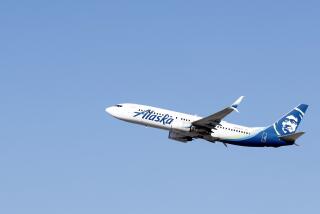Woes May Have Airbus in a Stall
Airbus’ double-decker A380 is a giant spaghetti bowl of electrical wires.
If the 100,000 individual sections of wire strung through the world’s largest passenger jet were laid end to end, they would stretch 330 miles, the distance from Los Angeles to San Jose.
The wires control virtually every function on the jetliner, including the pilot’s basic task of turning the 500-ton aircraft and enabling all 555 passengers to customize what they see on personal video screens.
Now some aviation industry experts are wondering whether all that wiring has short-circuited the aircraft giant.
The Toulouse, France-based aircraft maker announced last week that the A380 would be delayed another year -- pushing back the original delivery date by about two years -- because of problems encountered when installing the wiring. About 100 suppliers in Southern California make parts for the A380.
The fallout from the delay has reverberated through the company’s operations, with the prospect that Airbus could lose $6 billion over the next four years in sales, late penalty payments to customers and production cost overruns.
Airbus executives have begun talking openly about delaying the development of the A350WXB, a mid-size aircraft viewed by Airbus as fundamental to its future. It would compete with Boeing Co.’s 250-seat 787, which is in development and has garnered 377 orders.
Moreover, Airbus is considering dismantling a convoluted aircraft production system that was the foundation of its creation 35 years ago.
“Airbus must change, and change quite radically,” said Thomas Enders, chief executive of European Aeronautic Defense & Space Co., or EADS, the Brussels-based company that owns 80% of Airbus.
But such talk quickly created a political firestorm in Europe, where Airbus has been seen as the model for European cooperation. Created by a consortium of European aerospace companies in 1971 with the backing of the respective governments, Airbus surpassed Chicago-based Boeing in 2003 as the world’s largest commercial aircraft maker.
Last week, German Chancellor Angela Merkel and French President Jacques Chirac separately told Airbus executives that any reorganization or workforce cuts should be fair. Airbus operates 16 plants in France, Germany, England and Spain; major assembly work is done in Toulouse and Hamburg, Germany.
Chirac on Sunday defended Airbus’ new CEO, Christian Streiff, saying he saw no reason for him to resign as speculation swirled that he was set to bolt after just three months at the helm. Airbus has denied he is leaving.
Chirac and Merkel are expected to discuss Airbus’ woes when they meet this week in Paris. British officials, however, have told European politicians to stop interfering with Airbus’ management decisions. Two British plants make the wings for Airbus airplanes including the A380.
Aerospace analysts said politics might be the biggest challenge to reorganizing Airbus.
“Politics is mixing into this mightily,” said Hans Weber, a longtime aviation consultant in San Diego. “It’s going to be a real struggle.”
Airbus executives have declined to rule out anything, including the possibility of having all of the A380 assembled in Toulouse. Major sections of the fuselage are currently assembled in Hamburg, where the German government has provided financial help to build the new A380 facilities.
Under the Franco-German alliance that helped create Airbus, the fuselage is shipped to Toulouse, where it is mated with the wing and other sections of the aircraft. The aircraft is then flown back to Hamburg and painted. Installation of the seats and interior cabin is also done there. The plane is then flown back to Toulouse, from where it is delivered to the customer.
Some analysts believe that cultural differences and the division of the major work might have contributed to the wiring problem. In designing the plane, German engineers in Hamburg used older versions of design software based on the Unix operating system while their counterparts in Toulouse ran a newer Windows software.
Certain wiring changes that resulted from flight tests could not be made because the older software displayed wiring schematics in two dimensions while the new version showed them in 3D. As a result, the wiring done in Hamburg did not match that installed in Toulouse, including being short to meet up.
Engineers also found the software could not easily accommodate changes that would come from several different in-flight entertainment systems that the airlines wanted to install. As a result, Airbus said wiring installation that should take two months to complete was now going to take nearly six months.
“They never really forced people to get out of the legacy way of doing things,” Weber said. “In the past they got away with it because the demands weren’t so severe as this ambitious A380 program.”
Housing the aircraft’s assembly in one place would resolve some of the conflicts that were created by having two work sites, analysts said.
Airbus CEO Streiff said during a conference call with reporters last week that the network of manufacturing sites had to be restructured to cut costs. He raised the possibility of having more work done outside Europe.
Some analysts believe that Airbus could end up shuttering or selling half its 16 manufacturing facilities.
Airbus’ troubles have been a boon for Boeing, but executives at the U.S. company have refused to gloat, at least publicly. They are mindful of their own problems in the late 1990s and large workforce cuts after the 2001 terrorist attacks.
Production problems in 1997 prompted Boeing to overhaul its manufacturing process, and shortly after 2001 the company slashed about 40,000 jobs.
“There is no question Boeing is lean and Airbus is not,” said Allen C. Haggerty, an aviation consultant at Legacy Engineering and former head of engineering for the McDonnell Douglas MD-11 jumbo jet.
Streiff said in an interview last week with French newspaper Le Monde that the latest A380 delays had hurt Airbus’ competitiveness with Boeing.
“We will need 10 years to return to the same level as Boeing in terms of development and efficiency,” Streiff said.
Several large airline executives said the airline industry could ill afford to have Airbus fall too far behind Boeing.
“We need two strong healthy players,” said John L. Plueger, president of International Lease Finance Corp., Airbus’ largest customer and the world’s largest aircraft leasing company. “It would do no good for the industry overall for either player to take the backseat.”
Scott Hamilton, an aviation consultant at Leeham Co., said the A380 delays could be a “blessing in disguise” for Airbus.
“Had this crisis not happened, Airbus would have continued fat, dumb and happy,” Hamilton said. “Eventually they would have fallen on their own weight.”
*
More to Read
Inside the business of entertainment
The Wide Shot brings you news, analysis and insights on everything from streaming wars to production — and what it all means for the future.
You may occasionally receive promotional content from the Los Angeles Times.










